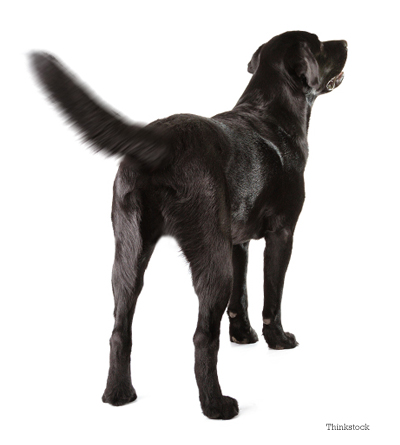
Dogs come in a multitude of sizes and shapes, and so do their tails: from the long, skinny tail of a Greyhound; to the big, bushy, curved tail of an Akita; to the little corkscrew tail of a Pug. No matter its appearance, though, your dog’s tail is a physically and emotionally moving part of his life and personality.
From a physical, utilitarian standpoint, tails in the animal kingdom serve a myriad of functions. Cows use them to swat at insects. Baby leopards and warthogs track on their mother’s tail tips to follow them through the tall grass. And monkeys use them to swing through trees. AnimalPlanet.com says Dogs’ tails were originally used for balance and that wagging their tails serves to transmit their individual marking scent. Beyond that, though, dogs also use their tails to communicate. The question is what are they saying? Or more specifically, what do we think they are saying?
Let’s face it. We really don’t know for sure. We can only speculate, especially since we don’t know how much of a dog’s tail movement is a result of conscious thought and how much if it is a result of unconscious thought. We do know that tails tell tales and there are some generally accepted interpretations.
What could tail position mean?
- The higher the tail, the happier1 or more dominant the dog is in the pack hierarchy
- A more horizontal tail indicates a content or curious dog1.
- A lowered tail, especially if tucked between the dog’s legs, implies fear, insecurity or submission.
What could tail wagging mean?
Puppies don’t start wagging their tails until they are about 6 weeks old1 and it’s not just domesticated dogs that wag. Even wild wolves wag their tails, says wolfcenter.com. At least for wolves, a rigid tail wag (like a pendulum) means the wolf is excited while a fluid wag of the tail (like a snake) signals play/greeting behavior.
According to NBCnews.com, research shows that dogs don’t wag their tails when they are alone, even when they are presumed to be happy. There is speculation that the direction of a dog’s tail wag is significant. BBC News reports that previous research has concluded happy dogs wag their tails more to the right (from the dog’s perspective) while nervous dogs’ tails tend to go to the left. Megan Gannon of The Washington post adds that studies show dogs tend to be relaxed when other dogs wag to the right, but become stressed when other dogs wag left.
What else can tell you how your dog is feeling?
While dog emotions may be indicated by positioning and movements of the tail, other things like the set or position of the ears, the overall body posture and hair must be considered when trying to decipher complex emotions. At the very least, tail wagging certainly seems to indicate excitement. We do have to be cautious about over-interpreting that excitement as always meaning happiness. Sometimes that excitement can be anxious anticipation. So remember that there are more clues to a dog’s emotional state than just the tail, and always look at the whole dog including stance, the position of ears, and the look in the eyes before you formulate a final opinion.
Click here to learn about avoiding dog bites.
Click here to learn about a dog's facial expressions.
If you have any questions or concerns, you should always visit or call your veterinarian -- they are your best resource to ensure the health and well-being of your pets.
Resources:
